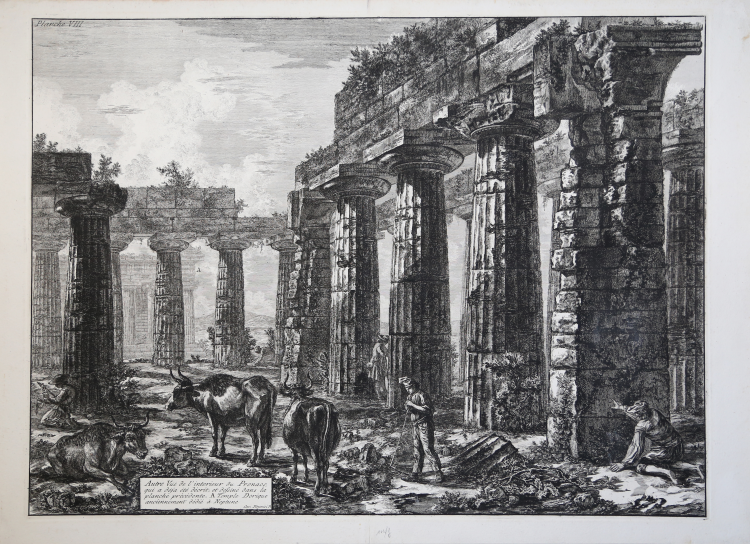



| Reference: | 38156 |
| Author | Giovan Battista PIRANESI |
| Year: | 1778 |
| Measures: | 660 x 488 mm |


| Reference: | 38156 |
| Author | Giovan Battista PIRANESI |
| Year: | 1778 |
| Measures: | 660 x 488 mm |
- CONTEMPORARY ROMAN EDITION -
Etching with engraving, 1778, signed on plate. Magnificent work, printed on contemporary laid paper with “lily in double circle with letters CB” (Robison 38) watermark, with full margins, showing vertical fold on verso, otherwise in good condition.
The series of the views of Paestum, realized in 1778, is the last work Piranesi realized before his death. Although he was already an archaeology expert, he went to visit the three temples in 1777 to realize his preparatory drawings for the engravings (twenty plates and the front page). Only 18 of these plates have been signed by Giovan Battista, while three bear the signature of his son, Francesco.
Actually, probably all the plates have been realized by the father with the help of his son, who might have realized the figures included in the landscape.
|
Focillon 590, Wilton Ely 725.
|
Giovan Battista PIRANESI (Mogliano Veneto 1720 - Roma 1778)
|
Italian etcher, engraver, designer, architect, archaeologist and theorist. He is considered one of the supreme exponents of topographical engraving, but his lifelong preoccupation with architecture was fundamental to his art. Although few of his architectural designs were executed, he had a seminal influence on European Neo-classicism through personal contacts with architects, patrons and visiting artists in Rome over the course of nearly four decades. His prolific output of etched plates, which combined remarkable flights of imagination with a strongly practical understanding of ancient Roman technology, fostered a new and lasting perception of antiquity. He was also a designer of festival structures and stage sets, interior decoration and furniture, as well as a restorer of antiquities. The interaction of this rare combination of activities led him to highly original concepts of design, which were advocated in a body of influential theoretical writings. The ultimate legacy of his unique vision of Roman civilization was an imaginative interpretation and re-creation of the past, which inspired writers and poets as much as artists and designers.
|
|
Focillon 590, Wilton Ely 725.
|
Giovan Battista PIRANESI (Mogliano Veneto 1720 - Roma 1778)
|
Italian etcher, engraver, designer, architect, archaeologist and theorist. He is considered one of the supreme exponents of topographical engraving, but his lifelong preoccupation with architecture was fundamental to his art. Although few of his architectural designs were executed, he had a seminal influence on European Neo-classicism through personal contacts with architects, patrons and visiting artists in Rome over the course of nearly four decades. His prolific output of etched plates, which combined remarkable flights of imagination with a strongly practical understanding of ancient Roman technology, fostered a new and lasting perception of antiquity. He was also a designer of festival structures and stage sets, interior decoration and furniture, as well as a restorer of antiquities. The interaction of this rare combination of activities led him to highly original concepts of design, which were advocated in a body of influential theoretical writings. The ultimate legacy of his unique vision of Roman civilization was an imaginative interpretation and re-creation of the past, which inspired writers and poets as much as artists and designers.
|